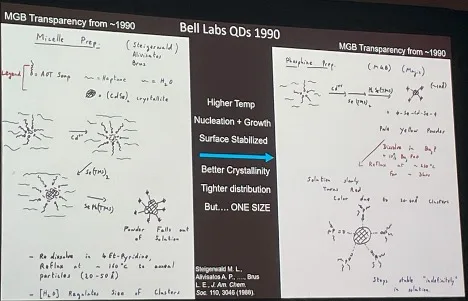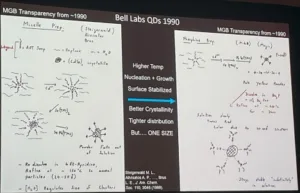I had been looking forward to Display Week 2024 and the keynote talk for many weeks, and it did not disappoint. Professor Moungi Bawendi (MIT), who received the Nobel Prize in chemistry last year, provided an engaging keynote address to a standing room only audience of thousands at the conference.
He started with a beautiful analogy of quantum confinement to the likes of a pipe organ providing sound with varying pitch, just as QDs can provide varying wavelengths of light based on their size. After providing thorough credit to his two co-recipients Brus and Ekimov, Bawendi launched into his personal journey through the discovery the synthetic methods to create well-controlled size nanocrystals of CdSe, an excellent model system that would lay the groundwork for the commercial scale synthesis of the QD systems used in displays today.
Interestingly, he dug up his original transparencies from 1990 where he worked through modifications to the existing aqueous micelle synthesis to improve the synthetic control and optical performance (fluorescence) by removing water and oxygen and creating stable nanocrystals of CdSe capped with phosphine ligands. The word “magic” is written in the upper right corner because, at the time, it was not repeatable, and the mechanism was not fully understood. Sometimes the most interesting science can only be described as “magic!”

The remainder of the talk described what has been done, and what can still be done with these “magic” particles including their use for solar energy conversion, biological imaging, infrared sensing, and even quantum computing.
Following the keynote session, we were treated to talks by two of professor Bawendi’s original students who were instrumental in helping with developing improved QD synthetic techniques with exquisite size control.
Professor Chris Murray (U Penn) provided his insights on the original synthesis of QDs in the early 90s. In the mid-90s, the QD performance went from “very bad” to “bad” based on current expectations with the concept of shelling the core QD to improve optical properties. He has spent most of his career creating and manipulating new types of nanoparticles to be useful in varying applications. Important control of surfaces of these materials was a common theme. As for the future, he is bullish on the opportunity of organizing QDs (and other nanomaterials) into “super structures” can unlock new features and optical properties that can enable new technologies.
Professor Dave Norris (ETH) told a story of how he continues to try to make brighter quantum dots. Finding so-called “bright exciton” QDs is like searching for a needle in a haystack. His group identified a number of materials that could show improved brightness due to changes in electronic states. There is great potential for these materials in higher flux environments like directly on LED chips.
The day capped off with a wonderful evening celebration for Professor Bawendi where he imparted, perhaps, the most important piece of guidance of all. “If you get the chance to win a Nobel prize… you should do it!”

Peter Palomaki is the owner and chief scientist at Palomaki Consulting. He is widely recognized for his display teardown videos and scientific approach to helping clients. He utilizes his expertise in quantum dots and materials chemistry to solve challenging problems with clients large and small.

